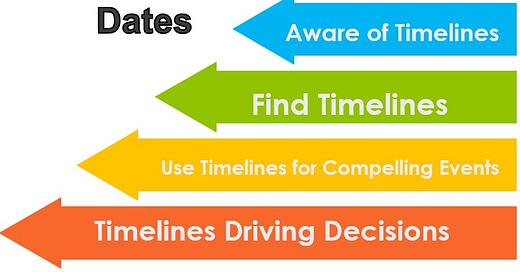What's an expiration date for a product leader? Other than the deadlines from your program manager, why pay attention to any other types of expiration dates?
When you are aware of deadlines, you can prevent unplanned costs. You won't miss an opportunity that needs your team's preparation. Additionally, expiration dates create compelling events for decisions.
Let's review a few cases of using expiration dates as a product leader.
Finding Expiration Dates
It takes work to find relevant expiration dates. You can ask questions about timing even in the most urgent situations. The deadline you expect might not be as dire as you hear in an emotional meeting.
For example, suppose you are the product leader for a SaaS product (Software-as-a-Service) and a salesperson reports a deal is about to be lost because of a feature in the next release. The customer wants the feature in two weeks to estimate their effort to integrate to your product. You learned this by asking questions about the situation. The questions you ask are:
When does the customer have budget for this project?
You learn that the customer's technical team is not available for two weeks and the budget is for the next year.
Does the customer have a test plan?
You learn the customer has a test plan and they will send it to you.
When does the sales team forecast this sale?
It is forecasted for next year after the customer integrates with their selected product.
With this information, you can propose a solution that meets the 2-week deadline and gives valuable information to the product team. You propose the following:
The customer tests the APIs first since the APIs didn't change for the new feature
The customer gets early access to your new release for their test plan
The customer agrees to give early feedback on the new feature
Your account team leads the early testing with the customer
This results in a successful test and the account team wins the deal. The customer uses the new release and provides a positive reference quote to your marketing team.
By understanding the expiration date of the deal and understanding the product plan, you were able to lead the team to a winning solution.
Using Expiration Dates
As a product leader, you are tuned in to your product's lifecycle. And you know key timeframes for typical projects such as the time from an accepted requirement to demonstration (1 or 2 sprints) or the time from a proof of concept until the requirement is accepted (varies by team). The ideal time to consider a requirement is right before sprint planning. A bad time for a new requirement is when the team is developing the next version of the product.
Your product lifecycle leads to expiration dates that you can use. For example, your customers have been asking about a new admin role in your product's UI. When you start your discovery work on the requirements, then you would use your requirements freeze deadline as an expiration date on the discovery work. This can be a major compelling event for customers to influence your product. Also, this helps you and the product team decide if the new admin role definition is ready for development or needs to wait for the next development cycle.
Conclusion
Soon you notice the expiration dates naturally as you lead your product. You ask more timeline questions to find just-in-time solutions. You have a deeper understanding of your product cycle times. Lastly, you use expiration dates to compel decisions and synchronize product plans.




